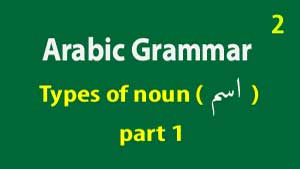Previous ➥ Lesson 11 ➥ Next
Arabic Noun
Types of noun in Arabic
From the Arabic parts of speech that we haved already learned in the previous lesson, we know that كَلِمَة
Please note that the last letter in a sentence (or in a solo word) is spoken سَاكِنْ (without harakat). During this learning course, we will read the last letter in the word or sentence along with harakat (not sakin). We need these last harakat to understand the grammatical concepts. We have discussed this topic earlier in the lesson tanween. However, grammatical terminologies can be read with the last word as sakin, e.g. كَلِمَة , حَرْف , جُمْلَة, etc.
We have seen that parts of speech in Arabic are the same as in English, but their arrangement or structure is different.
Like in English, the Arabic noun ( اِسْم ) is the name of anything, any person, any place (specific or non-specific).
Moreover, in Arabic grammar, adjectives and pronouns are also subdivisions of the noun.
Also, the name of an activity or action is a special subdivision of the noun. We are going to learn all these in this lesson.
In Arabic, اِسْم or noun is divided into three main types:
-
Definite noun
مَعْرِفَة -
Indefinite noun
نَكِرَة -
Verbal noun
مَصْدَر
The following is an introduction to the Arabic definite and indefinite nouns. We will discuss the details of these subtypes in the coming lessons, in a step-by-step way.
Definite noun
مَعْرِفَة
مَعْرِفَة or اَلِْاسْمُ الْمَعْرِفَة
اَلِْاسْمُ الْمَعْرِفَة is further categorized into:
-
اِسْم عَلَم
عَلَم or اَلْاِسْمُ الْعَلَم -
اِسْم ضَمِيْر
ضَمِيْر or in plural form ضَمَائِر -
اِسْم اِشَارَة
اَلْاِسْمُ الْاِشَارَة -
اِسْم مَوْصُوْل
اَلْاِسْمُ الْمَوْصُوْل is the relative pronoun, i.e. that, which, whome, etc. -
اَلْاِسْمُ الْمُنَادٰى
مُنَادٰى -
مُعَرَّف بِاللَّام
An indefinite noun ( نَكِرَة ) can be made definite by adding the prefix ( اَلْ ). For example, a man ( رَجُل ) is an indefinite noun but ( اَلرَّجُل ) is a definite.
مُعَرَّف بِاللَّام means making definite noun with the help of the prefix ل.
The letter ا before ل is a pronunciation requirement. We will discuss مُعَرَّف بِاللَّام in its own lesson. -
In اَلْمُرَكْبُ الْإِضَافِيُّ (possessive construction or Possessive phrase), an indefinite noun possessed by the definite noun becomes definite, e.g. in the sentence, 'A book of Haamid'.
'A book' here has become the definite noun ( مَعْرِفَة ) , because of its possession by a definite noun (Haamid).
Indefinite noun
نَكِرَة
Arabic indefinite noun has two subcategories.
-
اِسْم ذَات
اَلْاِسْمُ الْذَات -
اِسْم صِفَّة
اَلْاِسْمُ الْصِفَّة
Verbal noun
مَصْدَر
اَلْمَصْدَر
Characteristics of Arabic noun
To use any noun in a sentence or phrasal construction, we must know four characteristics (aspects) of that noun. These four aspects are:
-
Capacity of the noun
Difference between definite and indefinite nouns -
Gender of the noun
Whether the noun is masculine or feminine? -
Number of the noun
How to differentiate between singular and plural nouns? -
Grammatical case of the noun
Also called, status of the noun
How to use a noun in subjective, objective, and possessive cases?
Without knowledge of these above four aspects of an Arabic noun, we cannot use it in any sentence construction. We have started learning these four aspects from the capacity of the Arabic noun
Adjectives, pronouns, and other subcategories will be discussed in the coming lessons, as we proceed step by step. At the end of this lesson, we know what is a noun and what are its subtypes.
Previous ➥ Lesson 11 ➥ Next

